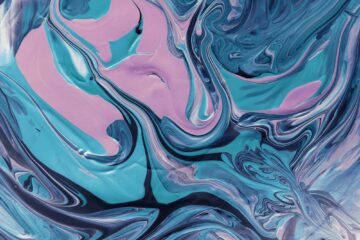Additives to make acrylic paint fluid can be expensive, especially for those who are just starting out or those who don't have that much budget to invest in these products. So, we pose the following question: is it possible to make fluid art without pouring medium? Yes, it is! Let's see the alternatives below.
Glues
It is possible to make the paint more fluid using white liquid glue. These glues dry transparent, so they do not change the color of the paint.
- Mod Podge: This is a brand of glue used by some artists. It does not change the color of the paint and manages to make it liquid very well, creating a good finish when it is dry. However, care must be taken not to expose the paintings to the sun, as it may yellow. In addition, after about a year, it can also start to yellow, even without having been exposed to the sun.
- Elmer Glue: This is another brand of glue that also doesn't change the color of the paint. It also has the problem of yellowing after a year or so.
- PVA Glue: this is perhaps the glue most used by artists, as it is possible to dilute the paint very well.
Water
If the budget is even lower, can we use water? This is a matter of debate among many artists. Some don't like to use water, as they say it breaks acrylic paint binders, which is true, if you put too much water. Others just use ink and water and it works perfectly.
I use just paint and water in many of my works. When I started, I spent money on pouring medium because I believed I couldn't use water at all, due to the testimony of other artists who didn't adapt to this method. However, I researched this alternative and there are artists who just use water to dilute their paint. At first, I made some mistakes and thought the water didn't work, but I kept trying. To add water, you need to follow these tips below.
- Distilled water: Distilled water is the best option as tap water can contain agents that interfere with the paint composition. This alternative is very cheap, you can buy a bottle of distilled water, which lasts for a long time.
- Add the water little by little: if you add all the water at once, the binders will break and it will be more difficult to dilute the paint. Also, you run the risk of the paint getting too liquid and not being able to be used. If the paint gets too liquid, during the drying process it can break and nobody wants cracks in their paints. Therefore, the ideal is to add the distilled water little by little, that is, you add a little water and mixes, then another little water and mix again, until you get the desired consistency.
- Paint brands: Water may not work with some artists because of the paint brand they use. The paints I use say on the label that they can be mixed with water. Therefore, look for paints that have this indication. Also, the brands Amsterdam and Pébeo can be mixed with water and are perfect.

And the air bubbles?
When we mix acrylic with water to make it fluid, some air bubbles can form. To avoid them, you can:
- Give light taps with the cup on the work table, for the bubbles to rise and disappear;
- Wait some time for them to come out naturally, for example, mix the paint at night and use the next day;
- Use a blowtorch, as the heat eliminates air bubbles.
In short, I prefer to just use water when I don't want to add a pouring medium. In my opinion, when the budget is low and you choose to use glue, you are spending money on it. Water is a good option; you simply need to know how to use it.


